
|
|
Twenty years have passed since the publication of the memorial book There Was a Shtetl in Lithuania – Dusiat Reflected In Reminiscences in Hebrew [August 1989], and now the time has arrived for the conclusion of the campaign of translating the book into English and publishing it on the Yizkor Book site of JewishGen. The moving responses received from the descendants of the Dusiaters, who are spread throughout the world, reinforce the importance of publishing the two versions.
It can be considered a wonder, that a small shtetl, “the size of a yawn” had so many documents and photographs from the distant past saved. To our great sorrow, only few of the first generation of “Dusiaters” are with us today. Unanswered questions remain, and there is no longer anyone who might have the answers.
In 1991 I took my first trip to the shtetl, an emotional and painful journey. I stood in front of the mass grave in the Deguciai Forest. “Only the trees that remain standing there will eternally be witnesses to the voices of the people and their cries, …” wrote Dovid-Leib in his lament. The trees were silent, and I cried bitterly.
We looked in vain for the wooden sign, the place where the first victims, seven Jews, were buried by the Russians after the war. Instead we found the monument to the victims whom the “local bourgeoises murdered on 27 June 1941.” Among the names was that of Meise Melamedas.
|
|
The appearance of the shtetl revealed to me was almost unchanged. The Lithuanians refused to talk about the past. “We came here after the war,” most of them said. I wandered through its three streets and went down to the lake. I recognized the houses, my grandfather's house too, and I went up to the attic. I took the only object lying there, a rusted and sooty lantern. “My only memento of my grandfather” – I said to the customs official in Vilna, who tried to prevent me from taking it out of Lithuania. “An ancient valuable object” – he said.
Groups of “Dusiaters” joined all my other trips – even members of the first generation, and photos from these visits were incorporated into the English edition. Documents and photos from the past were also incorporated into it, and especially moving were the documents sent to us by Olga Zabludoff from the archives in Vilna, and the documents from the Dusiat Archive, all of which were copied by Susan Cartun at the YIVO Institute. These are documents that bring tears to the eye when seeing the handwriting and signatures of a grandmother, a grandfather, uncles and aunts, and their importance is inestimable. Literally during the last period of time, the Mehlman sisters, Michal and Shlomit, sent me nine handwritten pages “Dusiat, Der Pesachdiker Purim Schpil”. My estimation is that it was written in the 1920's…
This July (2009) I visited the shtetl for the last time. The face of the shtetl is changing quickly. In Dusiat there are Lithuanians who were children when the Holocaust took place there. A few didn't hesitate to talk. There were those who remembered the names of Jews, and several spoke about the distress of the Jewish children in the Ghetto Unter-Dem-Brik (“Beyond the Bridge”), who were thirsty and starving and whose screams could be heard from afar. “We know that local Lithuanians carried out the murder” – they said. One woman told me how the local Lithuanian murdered Moshke Melamed: “I can see him standing before my eyes” – she said. “Suddenly one of the local Lithuanians shot at Moshke, he fell, and they shouted at me to go away…”.
|
|
Together with Prof. Saul Adelman, whose ancestors came from the shtetl, we mapped the cemetery in Dusiat. Two Lithuanians helped us discover gravestones from deep in the ground, Prof. Adelman photographed about three hundred gravestones, and our guide Regina Kopilevich and I copied down the inscriptions.
“Stones wear down as do you and I; but through books like yours their memory lives and their names will again live in the persons of their many descendants …”
“Those poor souls have come alive again through your good work. I'm sure they would all be so proud and thankful to you: a true mitzvah! …”
“… May this account keep alive forever the memory of our Shtetl Dusiat …”
There are not enough words to thank Hedva Scop, the project coordinator, Reuven Milon, the photographer and Judy Grossman, the translator, the dear people without whose involvement and unceasing help this version would not have been published.
Special thanks to all those whose invaluable support made the translation possible.
Sara Weiss-Slep
Haifa, December 2009
|
JewishGen, Inc. makes no representations regarding the accuracy of
the translation. The reader may wish to refer to the original material
for verification.
JewishGen is not responsible for inaccuracies or omissions in the original work and cannot rewrite or edit the text to correct inaccuracies and/or omissions.
Our mission is to produce a translation of the original work and we cannot verify the accuracy of statements or alter facts cited.
 Dusetos, Lithuania
Dusetos, Lithuania
 Yizkor Book Project
Yizkor Book Project
 JewishGen Home Page
JewishGen Home Page
Copyright © 1999-2026 by JewishGen, Inc.
Updated 25 Aug 2013 by LA